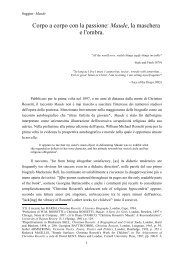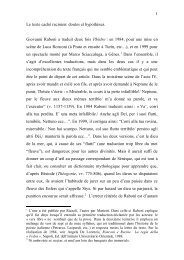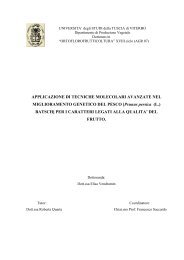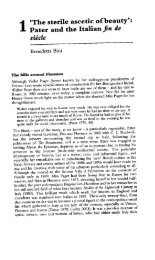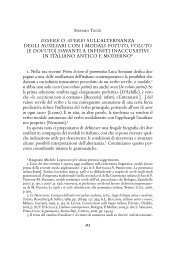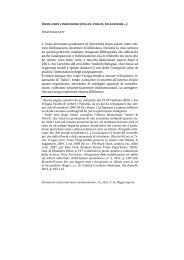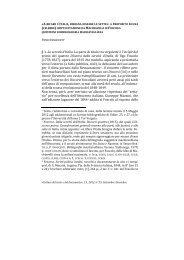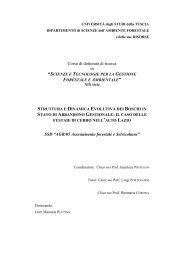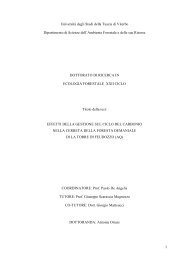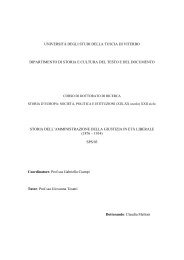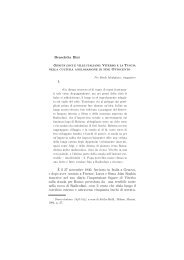drivers of soil respiration of root and microbial ... - Unitus DSpace
drivers of soil respiration of root and microbial ... - Unitus DSpace
drivers of soil respiration of root and microbial ... - Unitus DSpace
You also want an ePaper? Increase the reach of your titles
YUMPU automatically turns print PDFs into web optimized ePapers that Google loves.
an annual mowing the measurement was taken only once, so we are not able to account for a short<br />
term effect <strong>of</strong> defoliation.<br />
112<br />
Summarizing, our result show that factors affecting canopy C status <strong>and</strong> carbohydrate<br />
supply to <strong>root</strong>s influence both <strong>root</strong> <strong>and</strong> <strong>microbial</strong> <strong>soil</strong> <strong>respiration</strong> components being <strong>microbial</strong><br />
<strong>respiration</strong> affected both in short <strong>and</strong> long term <strong>and</strong> <strong>root</strong>-derived <strong>respiration</strong> affected clearly on the<br />
long-term bases. The effects were however buffered by increased <strong>soil</strong> temperature <strong>and</strong> <strong>soil</strong> water<br />
content under defoliation.<br />
4.4.2. Microbial activity <strong>and</strong> defoliation<br />
Our results prove a significant effect <strong>of</strong> grazing <strong>and</strong> mowing on <strong>microbial</strong> biomass<br />
community <strong>and</strong> its metabolic activity. The ratio <strong>of</strong> biomass C to <strong>soil</strong> organic C (qmic) reflects the<br />
contribution <strong>of</strong> <strong>microbial</strong> biomass to <strong>soil</strong> organic carbon (Anderson & Domsch, 1989). It also<br />
indicates the substrate availability to the <strong>soil</strong> micr<strong>of</strong>lora or, in reverse, the fraction <strong>of</strong> recalcitrant<br />
organic matter into the <strong>soil</strong> (Brookes, 1995). After a change, the <strong>soil</strong> <strong>microbial</strong> biomass responds<br />
more quickly to the change than does the amount <strong>of</strong> organic matter in the <strong>soil</strong>, which is relatively<br />
slower. Thus, qmic ratio will increase for a certain time if the input <strong>of</strong> organic matter to a <strong>soil</strong> is<br />
increased, <strong>and</strong> decreases if the input is decreased (Anderson <strong>and</strong> Domsch, 1989). The elevated<br />
value <strong>of</strong> qmic observed in this study in MG <strong>soil</strong>s, indicates a major availability <strong>of</strong> C substrates as<br />
confirmed also by the increase <strong>of</strong> easily available C source (Cext) which is considered an active<br />
organic fraction playing an important role in the substrate availability for microbes (Dumonent et<br />
al., 2001). Similar results were found by Uhlirova et al. (2005) reporting a significantly higher<br />
amount <strong>of</strong> potassium sulphate-extractable C in mowed grassl<strong>and</strong> <strong>soil</strong>s. In fact the positive effect <strong>of</strong><br />
defoliation on <strong>microbial</strong> biomass is <strong>of</strong>ten explained as due to an increase <strong>of</strong> <strong>root</strong> exudation,<br />
resulting in a larger supply <strong>of</strong> easily available C <strong>and</strong> energy sources to <strong>microbial</strong> communities,<br />
enhancing their biomass <strong>and</strong> nutrient cycling (Bardgett <strong>and</strong> Leemans, 1995; Bardgett et al. 1998;<br />
Guitian <strong>and</strong> Bardgett 2000; Kuzyakov et al., 2002; Kuzyakov <strong>and</strong> Domanski 2000; Rice et al.,<br />
1996; Zhou et al., 2006; Hamilton III et . al., 2008). Compounds that are exuded by <strong>root</strong>s <strong>of</strong><br />
defoliated grasses are comprised <strong>of</strong> organic acids, sugars <strong>and</strong> amino acids (Bokhari, 1977; Whipps,<br />
1990; Marschner, 1995) which stimulate rhizospheric processes <strong>and</strong> also the availability <strong>of</strong><br />
nutrients to the defoliated plants. Moreover <strong>microbial</strong> population in grazed grassl<strong>and</strong>s is sustained<br />
by inputs <strong>of</strong> labile C from dung deposition <strong>and</strong> increased <strong>root</strong> turnover/rhizodeposition beneath<br />
grazed plants (Tracy <strong>and</strong> Frank, 1998).<br />
Significant differences were observed in the metabolic activity <strong>of</strong> microorganisms between<br />
MG <strong>and</strong> UM plots: the <strong>respiration</strong> rates were significantly decreased by mowing <strong>and</strong> grazing either<br />
in the short term (MR24h) or in the long term (Cm). Also the initial potential mineralization rate




